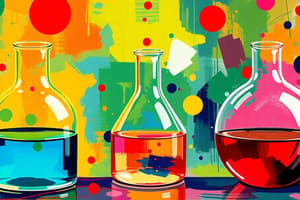Podcast
Questions and Answers
What are solutions?
What are solutions?
- Mixtures of a solute and a solvent
- Pure substances with no mixture
- Homogeneous mixtures of two or more pure substances (correct)
- Heterogeneous mixtures of two or more pure substances
Why are solutions important?
Why are solutions important?
- To separate pure substances
- To prevent the absorption of drugs
- In order to be absorbed and exert an action, a drug must be in solution (correct)
- To create heterogeneous mixtures
What 'drives' the dissolution process when a solid dissolves into a liquid?
What 'drives' the dissolution process when a solid dissolves into a liquid?
- Decrease in temperature
- Increase in temperature (correct)
- Increase in pressure
- Decrease in pressure
What term defines the extent of ionization of a weak acid or base at different pH values?
What term defines the extent of ionization of a weak acid or base at different pH values?
What do many drugs (APIs) behave as when dissolved in water?
What do many drugs (APIs) behave as when dissolved in water?
What do 50-65% of our body mass consist of?
What do 50-65% of our body mass consist of?
What is the process called when solvents are attracted to surface ions, forming a solvation shell around each ion?
What is the process called when solvents are attracted to surface ions, forming a solvation shell around each ion?
What is the term for the maximum amount of a solid that can dissolve in a liquid at a given temperature in dynamic equilibrium with undissolved solid?
What is the term for the maximum amount of a solid that can dissolve in a liquid at a given temperature in dynamic equilibrium with undissolved solid?
What theory defines acids as substances that can donate a proton and bases as substances that can accept a proton?
What theory defines acids as substances that can donate a proton and bases as substances that can accept a proton?
What equation is used to calculate pH values based on the concentration of the base and its conjugate acid?
What equation is used to calculate pH values based on the concentration of the base and its conjugate acid?
What occurs when the addition of an ion to a solution lowers the concentration of the other ion to maintain the solubility constant?
What occurs when the addition of an ion to a solution lowers the concentration of the other ion to maintain the solubility constant?
What does the enthalpy change of solution (DHsoln) represent?
What does the enthalpy change of solution (DHsoln) represent?
What is the term for the equilibrium term describing the maximum amount of a gas that can dissolve in a liquid at a given temperature?
What is the term for the equilibrium term describing the maximum amount of a gas that can dissolve in a liquid at a given temperature?
What is formed when a weak acid or base and its salt are combined to resist changes in pH upon addition of acid or base?
What is formed when a weak acid or base and its salt are combined to resist changes in pH upon addition of acid or base?
Flashcards are hidden until you start studying
Study Notes
- Solvents are attracted to surface ions, forming a solvation shell around each ion.
- Each ion is surrounded by solvent molecules, a process called solvation or hydration when the solvent is water.
- Ionic solids dissolve in water through a process involving the separation of solute and solvent particles, formation of new interactions, and enthalpy changes.
- The enthalpy change of solution (DHsoln) can be calculated as the sum of the enthalpies of the three processes.
- The enthalpy of solution can be either positive or negative, depending on the energy required to separate the particles and form new interactions.
- Solubility is an equilibrium term describing the maximum amount of a solid that can dissolve in a liquid at a given temperature in dynamic equilibrium with undissolved solid.
- The solubility of solid solutes in liquid solvents generally increases with temperature, while the solubility of gases decreases.
- The common ion effect occurs when the addition of an ion to a solution lowers the concentration of the other ion to maintain the solubility constant.
- Water dissociates into ions in a process called autoprotolysis, with the concentration of hydronium and hydroxide ions influencing the pH of the solution.
- The Lowery-Brønsted theory defines acids as substances that can donate a proton and bases as substances that can accept a proton.
- The pH of a solution is related to the concentration of hydrogen ions through the logarithmic scale of pH.
- Buffer solutions, made from a weak acid or base and its salt, can resist changes in pH upon the addition of acid or base.
- Aspirin has a pKa of 3.5 and a pH of 7.4 in the human body, with a large ratio of [A-]:[HA] indicating a solution that is predominantly the base form of aspirin.
- pH values can be calculated using the equation pH = pKa + log [A-]:[HA].
- References and further reading suggested include "Aulton's Pharmaceutics" and "Physicochemical Principles of Pharmacy."
Studying That Suits You
Use AI to generate personalized quizzes and flashcards to suit your learning preferences.




